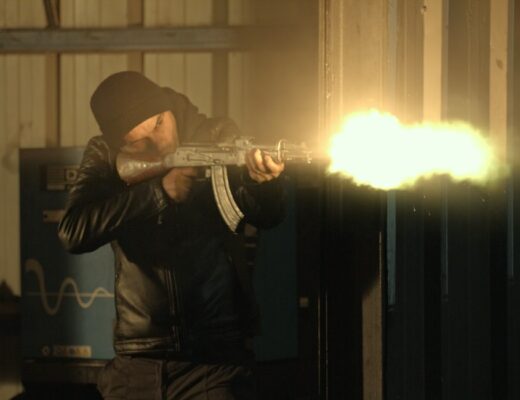Premiering at the 2005 Berlin Film Festival, before going on to win the prestigious Dragons & Tigers Award for emerging Asian cinema at that same year’s Vancouver Film Fest, Liu Jiayin’s Oxhide garnered near-universal praise from a who’s who of contemporary critics. Despite the accolades, Oxhide (along with its sequel, Oxhide II) has nonetheless remained stubbornly difficult to see in the intervening years, in no small part because Liu has created a film that defies easy categorization. A mostly straightforward narrative of a dysfunctional family, the film has been conceived of and executed in an experimental form, part fiction and part documentary, scrambling and remixing what we consider “realism.” Consisting of 23 shots over the course of 109 minutes, Liu documents her life in a small, 500-square-foot apartment in Shanghai with her actual parents, father Liu Zaiping and mother Jia Huifen. They are all playing fictionalized versions of themselves, and while certain narrative elements are drawn from their real lives, others are purely fabricated, with scenes carefully planned and movements choreographed in precise detail. Ultimately, whether or not Oxhide qualifies as a documentary is one of the least interesting things about it. What’s most remarkable is Liu’s command of cinematic space, a master class in framing and duration that conjures an entire universe of meaning in the cramped confines of this familial lodging. No one has ever made a film quite like this.
Shooting on Consumer-Grade DV cameras, Liu reportedly fashioned a makeshift apparatus out of construction paper and tape to mask the frame into proper widescreen. This DIY 2:35:1 image allows for all manner of off-kilter staging, as the compressed depth of field flattens the screen, essentially eliminating mid- and background space. The first shot of the film confounds the eye; a stack of blankets and pillows occupy the screen. Liu’s head enters the frame from the left, lingers, and then exits. Her father enters frame left, passing through the space Liu was just in, before he sits down in profile screen right. We hear her mother’s voice offscreen, before she too enters the frame, creating a suddenly cramped composition as mom and dad jockey for position. It’s a few moments before one realizes Liu was sitting on a bed, which is not visible, accounting for how adults of disparate size can be at roughly the same level simultaneously. Not quite a brain teaser, but by eliding simple architecture and placing her camera impossibly close to the action, Liu totally disrupts what would be an otherwise standard establishing shot. There’s a cut, and suddenly we are looking at abstract shapes along the edges and top of the frame, the center and right of the screen awkwardly empty. Eventually, one of the objects begins making noise, and we realize it’s a printer. Paper starts coming out and fills in the previously empty space, essentially “balancing” the composition. Oxhide is full of these kinds of moments, as Liu presents a focal point in each image before then “activating” the space in various ways. Even scenes of the family at rest — eating, fussing around the apartment, modeling various purses and handbags for each other — strike a precarious balance between chaos and order, as the edges of the frame cut off heads, arms, and legs, with dialogue emanating from disembodied figures. Nothing here is ever comfortable. One doesn’t wish to divorce the film entirely from a Chinese context; critic and InRO contributor Ryan Swen has noted that the family “hews to identifiable archetypes (especially familiar to Chinese families).” But part of the film’s power is that it expands and enlarges to comment upon any familial unit being ground down by labor, certainly a universal proposition in our modern era.
Indeed, labor occupies a significant part of the film’s runtime, as well as dominating most of the family’s conversations. The family runs a shop that sells leather purses and handbags, and the act of preparing raw materials (see the film’s title, for example) and fashioning them into sellable goods requires monumental effort. Here, Liu’s emphasis on duration lends weight to the acts on screen, as viewers get some sense of the time involved with each handmade object. One scene finds Liu Zaiping having a breakdown, tired of haggling over prices and ranting about shoppers who refuse to pay a fair price for his efforts. It’s a bracing reminder of the costs of capitalism, where the human element continually gets lost in the time-labor equation. Still, despite the heavy subject matter, moments of levity abound. Beyond the bickering and squabbling is genuine affection, and Liu has coaxed remarkable performances from her non-professional parents. The film’s gentle ending, as the family chats in their shared bed before falling asleep, suggests that despite the daily hardships, we can still avoid despair, at least for awhile; a damning indictment of society, certainly, but also a paean to the bonds of family. Speaking of Oxhide II in a 2009 blog post, David Bordwell called it “warm and engaging,” even “entertaining,” and a “demonstration of how a simple form, patiently pursued, can yield unpredictable rewards.” One can apply these superlatives to part 1 as well, which lacks part 2’s conceptual rigor but offers instead a thrilling unpredictability. Liu has said at various points that she had ideas for at least eight Oxhide films, or chapters, and several critics noted that a part 3 was being planned as of 2010. But Liu has yet to make another film since 2009, and her continued absence is a profound loss to modern cinema.
Part of Kicking the Canon – The Film Canon.







